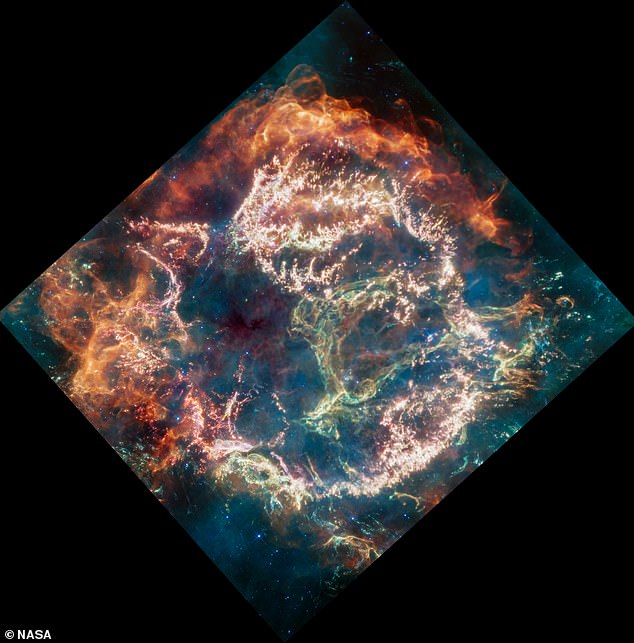NASA’s James Webb snaps exploding star 11,000 light years from Earth that looks like a Christmas tree ornament
NASA is celebrating the holiday season with images of the remains of a supernova star captured by the James Webb Space Telescope.
The star, called Cassiopeia A (Cas A), shines brightly about 11,000 light-years from Earth, making it look like an ornament more appropriate to place atop a Christmas tree than in the atmosphere.
NASA images show the inner shell of star dust, which looks like campfire smoke and emits bright orange and red colors, but it's the near-infrared camera (NIRCam) that shows Cas A's remnants reflecting the holiday spirit.
The Cas A image is part of a collaboration with the White House to “display the magic, wonder and joy” of the holiday season, NASA said in a press release, adding that it celebrates the new image from the Webb Telescope with First Lady Dr. Jill Biden.
NASA's James Webb Telescope has captured images of the remains of the Cas A supernova star that exploded 340 years ago
The NIRCam image shows a more detailed view of Cas A which gives off a visible purple diamond-like color but is actually ionized gas.
Cas A exploded about 340 years ago, leaving behind “filaments that look like tiny glass shards,” Danny Milisavljevic of Purdue University, who led the research team, said in a NASA news release.
“It is truly incredible that after all these years of studying Cas A to now resolve these details, which provides us with transformative insight into how this star exploded.”
The first images of Cas A were released in April and show “amazing details that we had never had access to before,” Te Tamim of Princeton University in Princeton, New Jersey, a co-investigator on the program, said in a NASA press release at the time. .
The team nicknamed Cass A the Green Monster because of a green ring running along the right side of the star's central cavity.
We nicknamed him the “Green Monster” in honor of Boston's Fenway Park. “If you look closely, you'll notice it's filled with what look like tiny bubbles,” Milisavljevic said in the initial press release.
This is the first time NASA has captured a high-resolution image of Cas A that was “previously inaccessible at these wavelengths” and shows details of the star's expanding walls colliding with the gas it released before it exploded.

NASA's MIRI camera captured the first close-up of Cas A in April. The star is located 11,000 light-years from Earth
Astronomers estimate that there are up to one septillion stars in the universe, of which 100 billion stars are in the Milky Way alone, including the Sun.
The lifespan of a star varies widely, ranging from a few million to trillions of years, and at the end of its life, before it expands and finally explodes into a cloud of dust, its core begins to collapse.
The star's core begins to run out of hydrogen and turns to helium which not only collapses the core but raises the star's temperature and pressure, causing it to slowly swell.
The star will continue to expand until it becomes a giant star, and eventually, its outer layers will explode, creating “an expanding cloud of dust and gas called a planetary nebula,” according to NASA.
Cas A exemplifies this, shedding its outer shell until it collides with a planetary nebula, causing it to explode.
The discovery of Cas A revealed the smallest known remnant of an exploding supernova star in our galaxy, and by monitoring the dust content, NASA said it could help astronomers understand how planets are created.
A NASA spokesperson told Dailymail.com: “Webb's new data can tell us what kind of dust is produced in a supernova explosion, how it forms, and how much dust survives the hostile journey into interstellar space.”
“In turn, this information can provide essential input for simulations that attempt to reconstruct the planet (e.g., grain size and composition).”
“By understanding the process of star explosion, we are reading our origin story,” Milisavljevic said in a NASA press release in April.
“I will spend the rest of my career trying to understand what this data set contains,” he continued.
(Tags for translation) The Daily Mail
